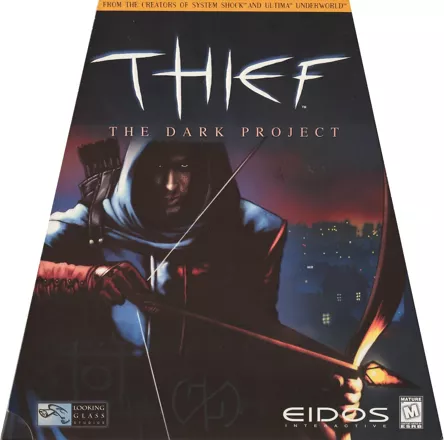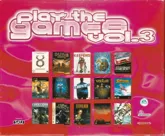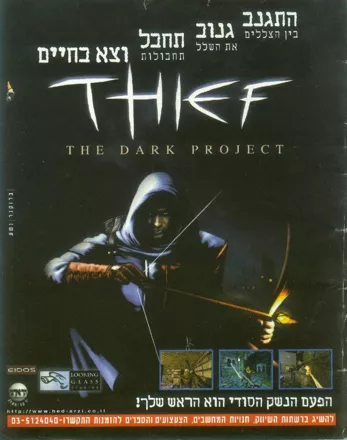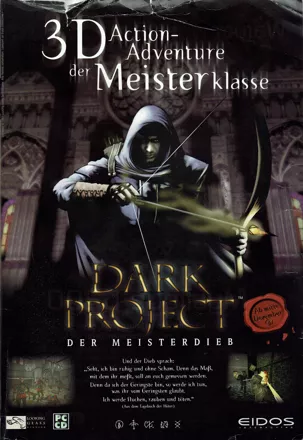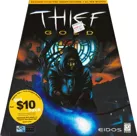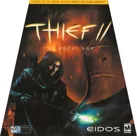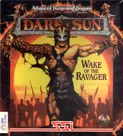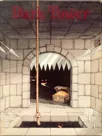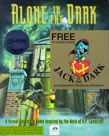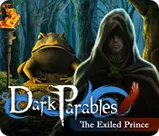Thief: The Dark Project
Description official descriptions
Garrett, discovered on the streets as a beggar, is taken in and trained by the secretive organization known as the Keepers. However, Garrett's plans for his training is different than that of his masters and so Garrett soon parts company. Surfacing as a master thief, Garrett must enter forbidden places and appropriate the treasures of the rich and the powerful. Of course this line of work is offensive to many people including the rich nobles, the town guard and the religious order of the Hammerites. If Garrett can keep his head while he relieves these forces of their valuable trinkets, he should be able to do quite well....
Thief: The Dark Project is a first person game focused on stealth. It is set in a metropolis called "the City", a medieval fantasy world with some elements from the industrial revolution era of technology. Garrett's main skills are in using the shadows to avoid being seen (the level of visibility indicated by a "light gem") and to avoid being heard (different surfaces make different noises). Guards can be alerted by either, and remaining hidden is ever important. Entering combat against armed opponents is not recommended, though some enemies (notably the various undead) can be taken on directly or avoided. It is also possible to silently sneak on guards, incapacitate them with the blackjack, steal their keys, and move their bodies.
At Garrett's disposal is a wide range of equipment, including lockpicks, a blackjack, a sword, flash bombs, holy water, explosive mines, and a bow which fires normal arrows in addition to water, fire, moss, rope, and noisemaker arrows. Each type of arrows has a unique purpose: water extinguishes torches, moss covers the ground to soften the sounds of footsteps, ropes can be used to climb in certain spots or cross chasms, etc.
The levels in the game are fairly open, and most of the time there are several paths and ways to accomplish the objective. Certain objects can be interacted with, moved from place to place, or destroyed. The game has three difficulty levels distinguished by the amount of goals needed to fulfill. Lower difficulty levels may allow the player to skip some of the harder areas due to the lack of a mission objective leading there. On higher difficulties, additional requirements (such as completely non-lethal way of finishing a stage) may be added. Loot gained from Garrett's thieving can be used to purchase additional equipment for the mission ahead.
Spellings
- 神偷 - Simplified Chinese spelling
Groups +
- 3D Engine: Dark Engine
- Game feature: In-game screenshot capture
- Gameplay feature: Body dragging
- Gameplay feature: Drowning
- Gameplay feature: Lock picking
- Gameplay feature: Pickpocketing
- Games with downloadable official map/level editors
- Green Pepper releases
- Setting: Church / Monastery
- Theme: Zombies
- Thief series
Screenshots
Promos
Videos
Add Trailer or Gameplay Video +1 point
See any errors or missing info for this game?
You can submit a correction, contribute trivia, add to a game group, add a related site or alternate title.
Credits (Windows version)
144 People (125 developers, 19 thanks) · View all
| Project Leader | |
| Lead Programmer | |
| Additional Programming |
|
| Lead Artist | |
| Lead Designer | |
| Himself | |
| Programmers | |
| Renderer | |
| Hardware Rendering and D3D Support | |
| Designers | |
| [ full credits ] | |
Reviews
Critics
Average score: 91% (based on 35 ratings)
Players
Average score: 4.1 out of 5 (based on 176 ratings with 15 reviews)
An utterly unique game in a world a copycats
The Good
Although a number of stealth games came out around the same time, Metal Gear most notably, this was the one that really focused on Not Being Seen. Yes you could take out your enemies with arrows or your sword but doing so was no guarantee, and a direct violation of the level goals if you were playing on hard mode. The most points, and satisfaction, was had through not even being seen on your way through a mission, which was very, very hard.
The game engine was built from the ground up to make sound propagation and shadows an integral part of the game world and it shows. In no other game do I remember standing in one location for five minutes hidden in shadows, palms sweaty, listening to the local sounds, waiting for my moment to reach out and snatch a key from an oblivious guard as he walked by humming while I prayed he didn't notice me. It's an impressive game that can make standing absolutely still for minutes tense and enjoyable.
The game is honestly scary. Not since System Shock had a game actually installed a sense of fear in me, but this one did, and I don't scare easily. It's ability to create an atmosphere, and back that atmosphere up with game-play, is amazing.
Add to that a unique story well told with good voice acting and strong art direction and you've got a sleeper hit. Many of it's levels were huge, sprawling affairs with multiple (and sometimes changing) goals and hidden areas galore with multiple ways of doing any given thing. It was a game you could get lost in and not mind it. A game you could finish and then play again and have a different experience and then play again because you KNOW you missed something. And because they released an excellent level editor there are fans making some fantastic new levels (and even new story lines) to this day (for Thief II mostly).
It and it's sequels are unique games, like no others before or after them, and it's not very often you can say that these days.
The Bad
Even at the time it was released the graphics were dated. Unreal and Quake were both out by then and the dark blocky graphics, low polygon models and limited special effects found in Thief just didn't measure up.
It had REALLY long load times, which was bad for a game in which you tended to die a lot.
The designers weren't sure of how their new 'sneaker' game-play would go over so they tried to hedge their bets by including a number of fight based levels and monsters which negated much of your sneaking skills. These are often sited as being the worst levels in the game.
It was hard, even at it's easiest level the learning curve for this new stealth game-play was quite steep in Thief and many people gave up playing after dieing numerous times. There is a reason the game came with 'normal', 'hard' and 'harder' difficultly level settings. And dedicating yourself to finishing all levels at the hardest setting while completing each objective and stealing every available piece of loot without ever being SEEN was a life time achievement. It's possible, and some have claimed to have done it, and all I can say is WOW.
The Bottom Line
Its a different game, and not for everyone. It's game-play is tricky and hard, even for Splinter Cell masters, and the story and art direction are unique with it's steam punk atmosphere, rock soundtrack and dark single City at night setting. But if you play it and like it, you'll never forget it.
Splinter Cell is now the crown jewel of stealth games, and justifiably so, but nothing feels like Thief. It's a dark gem, gleaming just outside the light ring of a guttering street lamp.
Windows · by Jeff Thomas (18) · 2005
The Good
Stealth has been an obscure, odd gameplay mechanic before Thief arrived and made it mainstream. Sure, there were stealth games, such as the groundbreaking yet nearly impossible Castle Wolfenstein or the interesting, yet arcadish and gimmicky Metal Gear. But nobody thought of making realistic stealth the core of gameplay, especially not in a first-person 3D game.
Thief is therefore a descendant of Ultima Underworld games and System Shock - revolutionary 3D games that used the capabilities of the engine to create immersive worlds and varied gameplay rather than focus on fast-paced action. Like those games, Thief is a masterpiece of game design, an essential link in an evolutionary chain that gave us some of the most advanced and beloved games of all times.
Thief is not just the first game to introduce full-fledged stealth-based gameplay in a 3D environment: it is the game that does it best. Its gameplay is so well-constructed that somebody out of touch with the history of video games would have sworn that its concept has been used countless times before and only perfected in Thief. In reality, it is one of those very rare games that deliver a new concept and a flawless execution of it right away.
The sneaking in Thief just feels right. Thanks to the generous level design, you never feel forced to do things a certain way. Yes, it is advisable to stay unnoticed, but you are not required to do so. You can incapacitate guards or simply try to avoid them. You can hit them with your blackjack and then hide their unconscious bodies. You can also try to take them on in direct sword combat, but be warned: even one-on-one fights are very tough, as they should be in a game where violence is the last resort. Most importantly, even with its strict concept, the game never feels rigid: you have freedom, you can dictate the pace. No solution is obvious, but none is obtuse. You can and should be creative, but even the hardest tasks are not frustrating because the game feels what you want from it, it is synchronized with your playing without being over-indulgent or artificial. That is something only very few games could pull off, and is one of the greatest achievements of Thief.
Your arsenal of tools is varied and impressive. The clever usage of the bow is one of the game's trademark inventions. Basically, your bow can act as a regular weapon in some cases, but it can also contribute to stealth. It is too bright in the hallway? Extinguish a torch with a water arrow from afar. Can't move silently on the pavement? Cover it with moss by shooting a special arrow. Feel the need to set something on fire? The appropriate arrows are at your service. There are also bombs and other cool little gadgets, as well as your trusty sword if things get too hairy. You can also grab, re-arrange, and throw different objects to distract enemies or for other purposes.
The game follows the fantastic GoldenEye concept of difficulty levels: the higher it is, the more objectives you need to complete in order to pass. This actually encourages you to play on higher difficulties to experience the game in a more complete form, and also means that playing on the lowest difficulty is by no means too easy: it is just less complicated. Also, a really cool touch is money management: you don't receive a salary or any awards based on your performance - you simply steal stuff which is then converted into money once the stage is finished. This further compels you to explore every corner of the stage in search of shiny golden things.
Level design is perhaps the most crucial element in game creation, and that's why the best game designers pay so much attention to it. Thief has a stellar level design that is seamlessly and masterfully interwoven with the demands of the gameplay and plays a key role in the creation of the game world. In other words, it is an integral part of the entire experience rather than just one well-made element. To illustrate, the secret areas in old first-person shooters were fun, but you could enjoy the game without them. System Shock, on the other hand, was built around exploration; it would lose most of its significance if it were linear.
Thief doesn't have a huge interconnected world like that game, but each and every level is an impeccably designed large area that creates the illusion of being in a real world while at the same time directly serving gameplay purposes. That is, it's not just about a vast environment with optional locations, but it's also not about conveniently placed passages that are there simply as an excuse to use yet another trinket. Such is the genius of level design here that you never feel you are "in a game", yet everything has its use precisely for game-related activities. There is so much thought and care put into designing those levels that even simple shooting gameplay set in them would elevate the game above the masses.
Equisite details make us forget the merely adequate 3D engine: Thief is gorgeous and will always stay so, because art always triumphs over technological limitations. Despite the uniformity of the setting, the levels are refreshingly varied: interiors of a lavishly decorate mansion, a desolate underground prison, mysterious catacombs, nostalgically beckoning stone-paved streets of a quiet medieval town, horrifying otherwordly realm - each location is unique, and you'll want to explore it again after you have finished the stage. Detail is everywhere, and you'll find yourself standing in empty rooms just to notice everything the designers have created.
No wonder that this results in an incredibly atmospheric experience. Thief is among the most magically atmospheric games ever made, perhaps on par with System Shock in that respect. The setting perfectly captures the cozily haunting "vibe" of the Middle Ages, and the touch of industrialization gives it its own peculiar flavor. It is "gothic" meets "steampunk": two of the most attractive visual genres are united in one game. You won't forget this world once you see a glimpse of it. It has little to do with supernatural elements: the stages with monsters are actually less absorbing than urban areas. Particularly the interior locations are masterfully done. And let's not forget the impeccable sound effects that are vital to gameplay as well as enhancing the atmosphere.
Far from being just a "thief simulator", Thief is a plot-driven game with a cohesive setting, based primarily on mission objectives as dictated by the story. While being somewhat in the shadows (much like the protagonist himself), the plot, evolving in stylish cutscenes, is interesting to follow to the end. Overhearing conversations and reading occasional documents helps establish the tone of the story even better. Thief also boasts a unique world with its own background information, organizations, religious beliefs, and so on.
The Bad
Most games that single-handedly define a certain concept are repetitive. Thief is no exception. It didn't use stealth as a harmless gimmick, as yet another option for flexible gameplay: it focused on it as seriously and as adamantly as possible. If Doom could get tiresome with monotonous shooting, Thief could get equally tiresome with monotonous sneaking. You'll have to avoid enemies and try to stay unnoticed pretty much for the duration of the entire game. The tension is constant, and there is no relief. You never get powerful - that's not what the game is about. But it is also counter-intuitive to our most basic instinct. Thief courageously and ingeniously opposed our primeval violent urges, but the abstinence becomes almost unbearable. It is therefore best played in short sessions, savored in small doses like a delicious, exotic meal.
Thief can also get quite hard, even on lower difficulty levels. Quicksave-abusing is not uncommon when you repeatedly try to pass a tough section and fail. Particularly hard are levels with undead enemies, which are perhaps the game's weakest link. It is fun to shoot zombies with holy water arrows when you first meet them, but after a while you realize that simply running past them is a better solution. If they really wanted to give us a break from sneaking (which I would welcome) they should have made those enemies much easier to defeat.
The Bottom Line
Thief is much more than a seminal 3D stealth game that popularized a gameplay element everyone have been inserting in their games ever since. It is also, miraculously, a nearly perfect incarnation of its revolutionary concept that few managed to imitate, and none have surpassed. But most importantly, it is a magnificent piece of game design for all players, a genre-crossing beauty with fantastic levels, deep gameplay, and haunting atmosphere. It is an essential classic proudly standing in the stellar row of the medium's highest achievements.
Windows · by Unicorn Lynx (181780) · 2014
The Good
Where do I start? This game spawned a new genre: The Sneak. I can't tell you how much pleasure I get from skulking around, unseen, from darkness to darkness. I guess it mirrors some of my real-life social anxieties. If only real life provided this many ways to hide. I need a light meter.
The scenery and the level design is terrific. It is a bit convoluted at times, but never a "maze". Once you get oriented you can find your way around. The cut scenes are probably the best of any game. Spooky! Creepy! You'll scream like a little girl once a hovering fireball fries you or the flatus of a bugbeast consumes you. And Garrett is cool, great voice talent, perfect attitude.
Awesome dialogue from NPCs. "Snap, snap, puppy."
The Bad
The people/creature models seem to be made of two polygons that converge in the center of their face. They're funny looking. I don't mind, I think it's hilarious. I got lost in a few places. After playing several times, I got the hang of it and enjoyed trying to find all the loot on a level. I still haven't found all the loot on some of the levels. It's hidden well. This isn't a complaint, though. It gives the game some extra re-playability. Also, my son was watching me play this when a giant spider jumped on my head and killed me. He started hyperventilating and crying. I nearly did myself. So this isn't for kids.
The Bottom Line
It's a spooky FPS (First-Person Sneaker). You use weapons sparingly and strategically. The thinking person's 3D adventure. This game is as good now as it was then. It's timeless.
Windows · by Thohan (17) · 2003
Discussion
| Subject | By | Date |
|---|---|---|
| Duality | hribek (28) | Mar 24, 2009 |
| What can/ could You take away (add?) | hribek (28) | Mar 22, 2009 |
| Garrett on steroids | hribek (28) | Mar 22, 2009 |
| Garret looks like Nicholas Cage? | hribek (28) | Mar 13, 2009 |
Trivia
1001 Video Games
Thief: The Dark Project appears in the book 1001 Video Games You Must Play Before You Die by General Editor Tony Mott.
Basketball
Like other Looking Glass games like System Shock and System Shock 2, this game also contains a hidden basketball court. (See Tips & Tricks for details on accessing it.)
Development
Originally, Thief was to be a game called Dark Camelot where Merlin was a time-traveler but it eventually became Thief... before that it was a game involving Communist zombies!
Editor
Thief fans requested the level editor, so Looking Glass Studios released DromEd (subsequently included on the Thief (Gold) and Thief II disks), there are now hundreds of fan missions available for download.
Hammerites
"The Hammer of Light" in the game are a group of religious warrior/knights, similar to the Knights Templar during the height of their power in Europe
Inspiration
Members of the design team have said that books by Umberto Eco (The Name of the Rose among others) were a big inspiration for the atmosphere and setting of the game.
Taffer
According to an interview made by the now defunct PC accelerator to project designer Steve Pearsall the word "Taffer", which many fans went to great lengths to define as some sort of long-lost "olden" word, was actually created by level designer Laura Baldwin. It was originally meant to be some sort of slang for common criminal but it evolved from that point on.
Thievery
There is a group of people working on a free Thief inspired conversion for Unreal Tournament. It can be accessed it from http://www.thieveryut.com.
Awards
- Computer Gaming World
- April 1999 (Issue #177) – Runner-up as Best Action Game of the Year
- GameSpy
- 2001 – #40 Top Game of All Time
- GameStar (Germany)
- Issue 12/1999 - #45 in the "100 Most Important PC Games of the Nineties" ranking
- Issue 03/2000 - Most Innovative Game in 1999
- Issue 12/2008 - One of the "10 Coolest Levels" (For "The Sword". It uses the player's expectations against him - instead of the usual quick burglary, it sends him on a horror trip which manages to wear out Garret's earned self-confidence.)
- PC Gamer
- April 2000 - #27 in the "All-Time Top 50 Games Poll" (tied with Tribes)
- PC Player (Germany)
- Issue 01/2000 - Best 3D Stealth Game in 1999
- Power Play
- Issue 02/1999 – Best Action-Adventure in 1998
Information also contributed by Jack Lightbeard, Neon Hammerite, PCGamer77, Scott Monster; WildKards and Zovni
Analytics
Upgrade to MobyPro to view research rankings!
Related Sites +
-
The Circle of Stone and Shadow
A huge fan network dedicated to the Thief Series. Including everything from user-crafted levels to fan fiction. If it is Thief-related, odds are that you'll find it here. -
Thief: The Dark Project
Official Website
Identifiers +
Contribute
Are you familiar with this game? Help document and preserve this entry in video game history! If your contribution is approved, you will earn points and be credited as a contributor.
Contributors to this Entry
Game added by robotriot.
Additional contributors: Trixter, blade51, Zovni, Indra was here, Rantanplan, Shoddyan, sfabien, Jack Lightbeard, Havoc Crow, Ms. Tea, Kidofthecentury, Patrick Bregger, FatherJack.
Game added November 1, 1999. Last modified March 27, 2024.
